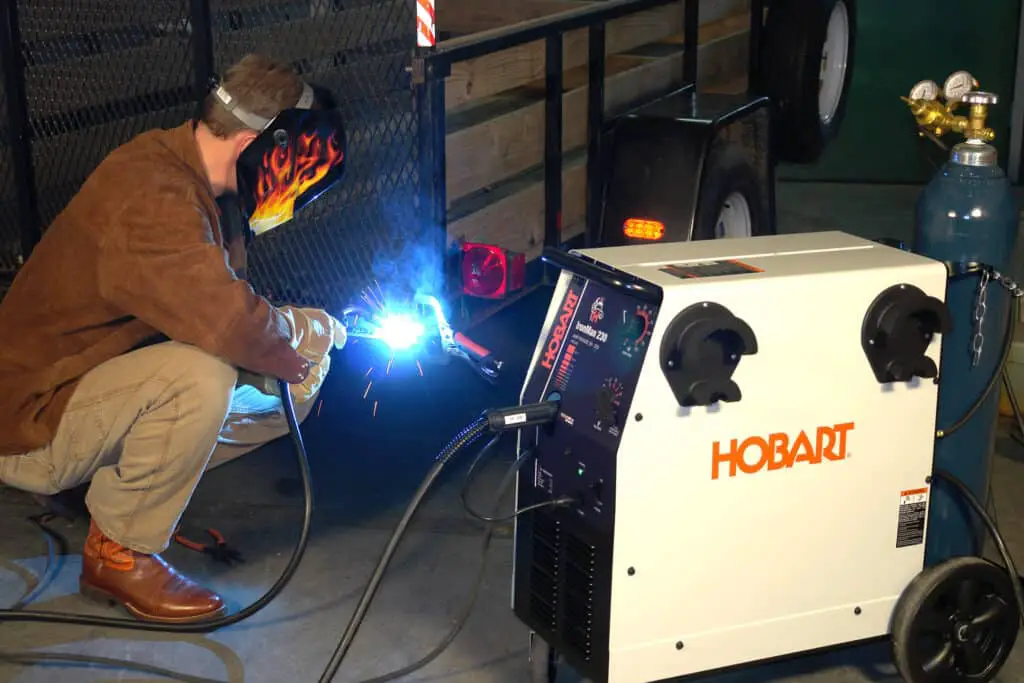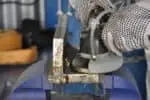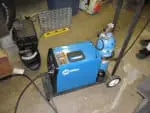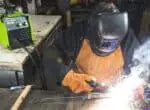If you are in the market for a quality MIG welder, there are quite a few aspects that could influence your choice. Weight, portability, duty cycle, metal thickness, input voltage, and a whole lot more will be factors in your final decision.
Investing $2000 in a MIG welder is a substantial sum of money for a power tool, so we asked our team of professional welders to research and test a myriad of various models.
After lots of welding, we chose Hobart MIG Ironman 240 Welder as our top overall MIG welder pick for under $2000.
This MIG welder offers exceptional arc quality and 280A capability. It is a physically large welder complete with wheels for easy portability that features an impressive duty cycle of 60%@200A.
Another welder that caught our attention for the features it offers is the Miller 211 MIG Welder Millermatic® 120/240 VAC. Ideal for DIYers, ranch, farm, racing, restoring, customizing, it comes with all of the equipment for you to weld aluminum, stainless steel, or mild steel.
| Welder | Voltage | Amperage | Duty Cycle | Features |
|---|---|---|---|---|
| Hobart MIG Ironman 240 Welder | 240V | 30 to 280A | 60%@200A | Comes with wheels; 12 settings for voltage; 15-ft. MIG gun; Gas cylinder rack |
| Lincoln Electric #K3963-1 MP 115/230V Power MIG 210 MP | 115/230V | 210A | 0.3 | MIG, Flux Core, DC Stick, DC TIG, Lightweight and portable; Automatic setting selection; Digital display |
| Miller 211 MIG Welder Millermatic® 120/240 VAC | Dual voltage, 110/115/120V 220/230/240V | 30A to 230A | 40%@150A and 20%@115A | Welds aluminum, steel, and stainless; Fan-on-demand cooling; Generator compatible; Inverter technology; Auto set for material thickness; Multi-voltage plug |
Our Favorite MIG welders Under $2000
Best Overall MIG Welder Under $2000
1.) Hobart MIG Ironman 240 Welder
- Infinite voltage control
- Delivers 30 to 280 amps of pure power
- Spool hub assembly accommodates 2-, 10-, 33- and 45-pound spools.
- Fan-on-Demand
- Spool gun ready
Prices pulled from the Amazon Product Advertising API on:
Product prices and availability are accurate as of the date/time indicated and are subject to change. Any price and availability information displayed on [relevant Amazon Site(s), as applicable] at the time of purchase will apply to the purchase of this product.
This powerful MIG welder from Hobart is our overall top pick for its exceptional arc quality and 280A capability. It features an impressive duty cycle of 60%@ 200A.
It is a physically large welder, but Hobart has considered this in the design because it comes complete with wheels for easy portability. The design also features a rack for gas cylinder storage.
Most hobbyists may not need this much power in a welder, but it does open the doors to larger projects. Infinite wire speed control and a whopping twelve voltage settings make this our top overall selection. This machine can weld up to ½-inch thick steel.
Pros
-
-
- High-quality construction
- Durability
- Powerful
- Comes with wheels
- 12 settings for voltage
- 15-ft. MIG gun
- High duty cycle
-
Cons
-
-
- Heavy and large to maneuver
- Without 110V capability
-
Best Multi-Process MIG Welder Under $2000
2.) Lincoln Electric MP 115/230V Power MIG 210 MP #K3963-1
- Dual Voltage Inputs (120V or 230V) means you can plug into any common power supply
- Lightweight and portable–just 40 lbs.
- Intuitive push-and-turn digital controls make setup a breeze
- Large color display guides you through the setup process
- Advanced options and settings are simple to access
Prices pulled from the Amazon Product Advertising API on:
Product prices and availability are accurate as of the date/time indicated and are subject to change. Any price and availability information displayed on [relevant Amazon Site(s), as applicable] at the time of purchase will apply to the purchase of this product.
For welders that can invest a bit more, this MIG welder from Lincoln Electric is a terrific option. It is an optimal welder for its versatility because it can perform TIG, Stick, Flux Core, and of course MIG.
If you’re in the market for a MIG welder this is exceptional, but if you’re considering other types of welders, it’s even better. You’ll be able to save some money in the long term as well.
This is a top-notch welder for both machine construction as well as welding performance. It features a digital display for easy insertion of variables and has a user interface that is easily operated.
Pros
-
-
- Lightweight and portable
- Automatic setting selection
- Dual voltage
- Digital display
- Excellent build
- MIG, TIG, Stick, Flux Core capabilities
-
Cons
-
-
- Without AC TIG for welding aluminum
- Not MIG only if that’s your goal
-
Best Heavy-Duty MIG Welder Under $2000
3.) Miller 211 MIG Welder Millermatic® 120/240 VAC
- Millermatic 211 Aluminum - Material Thickness: 18 ga. to 3/8 Mild Steel - Material Thickness: 24 ga. to 3/8 Stainless Steel - Material Thickness: 20 ga. to 1/4 Hz: 60 Input Amps: 17
- Millermatic 211 MIG Welder with Advanced Auto-Set - 907614
Prices pulled from the Amazon Product Advertising API on:
Product prices and availability are accurate as of the date/time indicated and are subject to change. Any price and availability information displayed on [relevant Amazon Site(s), as applicable] at the time of purchase will apply to the purchase of this product.
This is a fantastic heavy-duty, durable MIG welder from Miller Electric. Ideal for DIYers, ranch, farm, racing, restoring, customizing, and even metal art, this machine can handle any welding project.
Manufacturer Miller Electric is a powerhouse in the welding industry and provides all of the equipment so you can weld aluminum, stainless steel, or mild steel.
For those that can invest a bit more in a MIG welder, this machine certainly merits attention. Differing from other MIG welders, this welder is relatively lightweight at under 50 lbs. and makes very little noise during operation.
It also offers consistent performance whether welding aluminum, mild metals with flux core, and of course MIG applications.
This is a fantastic MIG welder but not necessarily for newcomers to welding because the provided tools and functions require a more experienced level. It can be used by pros for heavy-duty tasks and at construction and industrial sites.
The welding thickness for mild steel is 24 gauge to 3/8-inch while for aluminum it is 18 gauge to 3/8-inch. Input voltage is 110/115/120 – 220/230/240 and the amperage is from 30A to 230A. The welder’s duty cycles are 40%@150A and 20%@115A.
Pros
-
-
- Lightweight at 38 lbs.
- Amperage 30A to 230A
- Quiet operation
- DC type
- Welds steel, aluminum, and stainless
- Fan-on-demand cooling
- Generator compatible
- Inverter technology
- Auto set of material thickness
- Multi-voltage plug
-
Cons
-
-
- Quality control issues
-
Features, Functions, and Factors
1.) Welding Machine Type
Most MIG welders will be flux core, need shielding gas or perhaps offer both. Flux core welding is popular because it doesn’t require you to use shielding gas and hook of a gas cylinder. On the downside, flu core welding does produce slag that then needs to be removed after the weld.
A lot of MIG welders will have both MIG and flux core capabilities, although a few will have only one or the other. Having both functions afford you more versatility.
2.) Brand
Reliable manufacturers of welding equipment will give you a certain amount of peace of mind when it comes to machine durability and performance as well as the availability of consumables, accessories, and parts.
Brands like Everlast, Hobart, Lincoln, and Miller are renowned for product quality. Also, well-known industry giants usually offer dependable customer service.
3.) Cost
Buy the best quality welder that your budget allows. The most expensive welder will not automatically be the better choice for your welding needs. Know your needs and your budget.
Select the welder that gives you the best quality/price ratio. You want the best performance for the money that you can spend.
4.) Duty Cycle
The welding machine’s duty cycle is crucial when choosing. If you need to weld for long periods continuously, you need a higher duty cycle. The machine’s duty cycle will be indicated as a percentage.
The percentage indicated will show how long your welder can operate in ten minutes without overheating.
A duty cycle of 60% means that the welder can operate for six minutes and then will need to cool down for four minutes.
Some welders will have lower duty cycles coupled with higher power outputs. This will tell you that the machine needs longer to cool down. Larger welding machines often have fans to minimize the cooling down period.
To prevent overheating many welders have specific protection for thermal overload. This function will shut the welder off if you are about to run longer than the indicated duty cycle.
5.) Machine Size and Portability
When you select your welder, consider if you will need to transport it to different job sites or if it will be permanently stored in your workshop. If you need to move it, size and weight will come into play.
When carrying it from one place to another, you’ll be happy to have a welder that has a comfortable weight and a handle. If you require a large, heavy-duty welder, look for one with a cart with wheels for easy maneuverability.
A good quality MIG welder will probably weigh at least 25 to 30 lbs. These smaller, lighter machines usually boast inverter technology which will reduce the weight. Heavy industrial-grade machines can easily weigh at least 200 lbs.
6.) Power Output
How much power output you need will depend on what you want to weld. Most welders will come with indications for the correct settings for the metal thickness, so your weld quality is assured.
7.) Spool Gun
If your welding projects include aluminum, you need a spool gun for your welder. Some of the smaller welding machines will not perform aluminum welding.
If this is a must for you, check for one when purchasing. Also, when selecting a spool gun for your machine, a quick-release feature will be convenient.
8.) Warranty
Warranties are an important consideration when investing in any power tool. Some of the principal manufacturers offer three-year or five-year warranties.
This shows the manufacturer’s backing of the product. If you are buying a lesser-known product, research client reviews and warranty terms before purchase.
Welder Input Voltage
MIG welders come with a variety of input voltages, so it is important to have a welder with an input voltage that is compatible with the electrical outlet where you will be welding.
Some will have 110/115/120V while others will have 220/225/230V. You may find several that will offer both.
→ 110V Welding Machines are fine if you weld as a hobby at home because they can be plugged directly into your home socket. This voltage, however, does limit the amount of output power you can obtain. You will not be able to weld thick pieces of metal unless you increase both amperage and power.
→ If you need to weld thick metals, you should select a 220V welding machine. Where you weld there should be a 220V power outlet. 220V welders are generally used at industrial sites where 110V power outlets are rare.
Necessary Welder Equipment for Your MIG Welder
Along with the welder, there are some other articles you should have for safety and welding performance.
1.) Clothing
Protective clothing is a must when welding. Welding gauntlets and long-sleeved shirts are a given along with welding aprons. Clothes should not be synthetic and preferably have flame-retardant treatments.
Welding appropriate work boots with metatarsal protection and a welding helmet are also recommended.
2.) Gas Cylinder
MIG welding requires a gas cylinder. Depending on the application, you will choose the gas for that type of welding. One of the most popular is carbon dioxide because it’s priced lower than other kinds. More expensive gases will give you a better-quality weld and less spatter to deal with.
3.) Gas Regulator
Your Gas cylinder needs a gas regulator during operation. There are a variety of regulators that you can buy such as a single gauge, dual gauge, or even a gauge-less regulator.
A quality dual gauge regulator will show you how much gas is still in your gas cylinder and the gas flow meter so you can control the flow depending on the type of gas in use.
A single gauge regulator will be less expensive but will only show how much gas is left, and you’ll need a flow meter that is non-gauge.
4.) MIG Torch
Most welders will come complete with their MIG torch but check before purchasing.
5.) Welding Mask
This is the most crucial piece of PPE that you will use when welding. MIG welding features an incredibly bright arc that can damage your eyes if not blind you.
Helmets with darkening filters will protect you from eye injury but will enhance weld pool vision. Costs vary, with the more expensive helmets offering you auto-darkening capabilities.
Conclusion
We hope this guide will get you started on finding the best MIG welder under $2000 for your welding projects. Define what your welding needs are and where you will be welding most often to get the best product for your monetary investment.










